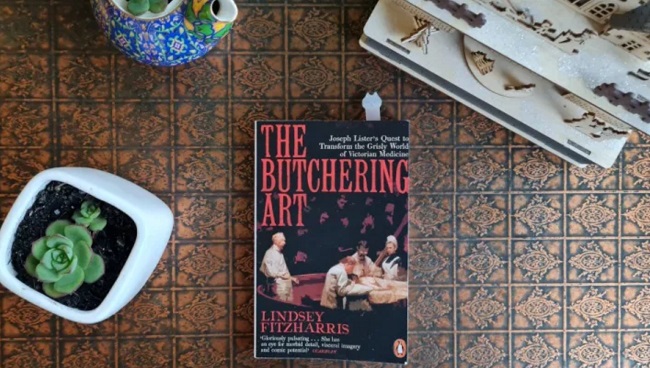“The Butchering Art” by Lindsey Fitzharris is a gripping account of a transformative period in the history of medicine. This meticulously researched book takes readers on a journey into the gruesome world of Victorian surgery, where death often lurked in the shadows of the operating theater.
At the heart of this narrative is Joseph Lister, a pioneering figure who embarked on a quest to revolutionize surgical practices and save countless lives.
In this article, we delve into the vivid details of “The Butchering Art,” exploring the shocking state of Victorian medicine, Lister’s groundbreaking contributions, and the lasting impact of his work on modern healthcare.
Join us as we uncover the compelling story behind one of the most influential figures in the history of surgery.

And they were perplexed by the tenacious infections that contributed to the consistently high mortality rates.
A young, melancholy Quaker surgeon named Joseph Lister emerged at a time when surgery could not have been riskier to solve the mystery and alter the course of history.
Read Also:
- How Much do Squirrels Weigh?
- Why do Deserts Get Cold at Night
- Difference Between Crocodile and Alligator and Gharial
Transforming The Grispy World of Victorian Medicine
Lindsey Fitzharris’s biography of surgeon Joseph Lister vividly brings to life the sights, sounds, and aromas of mid-nineteenth-century medicine from the very first pages.
Bloodied surgeons slashed through testicles and helpers’ fingers in their rush to perform amputations using equipment that were still soiled from prior surgeries.
Because of the high mortality rate associated with surgery, operating rooms earned the nickname “gateways of death.” It was a common practise for doctors to go through graveyards in search of cadavers so they could practise operating on patients who had suffered broken legs.
Fitzharris clearly portrays the postoperative suppuration that plagued patients before the advent of anaesthetic in the 1840s, which allowed surgeons to do longer, more difficult procedures.
The stench of Victorian London, Edinburgh, and Glasgow is described in detail by Fitzharris as he narrates the rise of Quaker surgeon Joseph Lister.
Using carbolic acid, Lister pioneered antiseptic surgery, which is still widely practised today.
His antiseptic mist carbolic spray apparatus and irrigation methods were two of many things he worked tirelessly to perfect.
Books: The Butchering Art: Joseph Lister’s Quest to Transform the Grisly World of Victorian Medicine
From the very beginning, the reader is immersed in the sights, sounds, and aromas of mid-nineteenth-century medicine thanks to Lindsey Fitzharris’s narrative of the life of surgeon Joseph Lister.
Bloodied surgeons slashed through testicles and helpers’ fingers in their rush to perform amputations using equipment that were still soiled from prior surgeries.
Because of the high mortality rate associated with surgery, operating rooms earned the nickname “gateways of death.”
It was a common practise for doctors to go through graveyards in search of cadavers so they could practise operating on patients who had suffered broken legs.
Fitzharris clearly portrays the postoperative suppuration that plagued patients before the advent of anaesthetic in the 1840s, which allowed surgeons to do longer, more difficult procedures.
The stench of Victorian London, Edinburgh, and Glasgow is described in detail by Fitzharris as he narrates the rise of Quaker surgeon Joseph Lister.
The Grisly World of Victorian Medicine
“The Butchering Art” immerses readers in the brutal reality of medical practices during the Victorian era. In a time when surgery was often a last resort and anesthesia was not yet widely used, patients faced excruciating pain and a high risk of infection.
Operating theaters resembled gruesome spectacles, with surgeons performing procedures in front of audiences without proper hygiene or understanding of germs.
The graphic descriptions of surgical procedures in the book highlight the horrors patients endured and the dire need for reform in the medical field. The stench of blood and pus, combined with the prevalence of post-operative infections, painted a grim picture of healthcare in the 19th century.
Joseph Lister: The Hero of the Operating Theater
Amid this grim backdrop, Joseph Lister emerged as a beacon of hope for both patients and surgeons. Lister was a Scottish physician who dedicated his life to understanding the causes of infections and finding ways to prevent them.
His pioneering work on antiseptic principles would forever change the course of surgery. Lister’s key innovation was the use of carbolic acid (phenol) to sterilize surgical instruments, hands, and the operating environment.
He introduced the concept of antiseptic surgery, which aimed to eliminate harmful microorganisms that caused infections. Lister’s meticulous attention to cleanliness and the use of antiseptics drastically reduced the mortality rate associated with surgical procedures.
Impact on Modern Healthcare
Joseph Lister’s contributions to medicine had a profound and lasting impact. “The Butchering Art” not only chronicles his groundbreaking work but also underscores the importance of scientific innovation in healthcare.
Lister’s principles laid the foundation for modern aseptic surgery, where rigorous sterilization protocols are followed to minimize the risk of infections. His legacy is evident in today’s operating rooms, where cleanliness and infection control are paramount.
Furthermore, Lister’s work paved the way for the development of antibiotics, such as penicillin, which further revolutionized medicine by effectively treating infections that were once deadly.
Read Also:
Conclusion
“The Butchering Art” by Lindsey Fitzharris is a compelling exploration of Joseph Lister’s quest to transform the grisly world of Victorian medicine.
Through meticulous research and vivid storytelling, the book provides readers with a harrowing yet enlightening glimpse into the past. Lister’s pioneering efforts not only saved countless lives during his time but also left a lasting legacy that continues to shape modern healthcare.
As we reflect on the horrors of Victorian surgery and the heroism of Joseph Lister, we gain a deeper appreciation for the progress made in medicine and surgery.
“The Butchering Art” serves as a testament to the power of innovation, perseverance, and a commitment to improving the well-being of humanity. It is a must-read for anyone interested in the history of medicine and the remarkable individuals who changed it for the better.